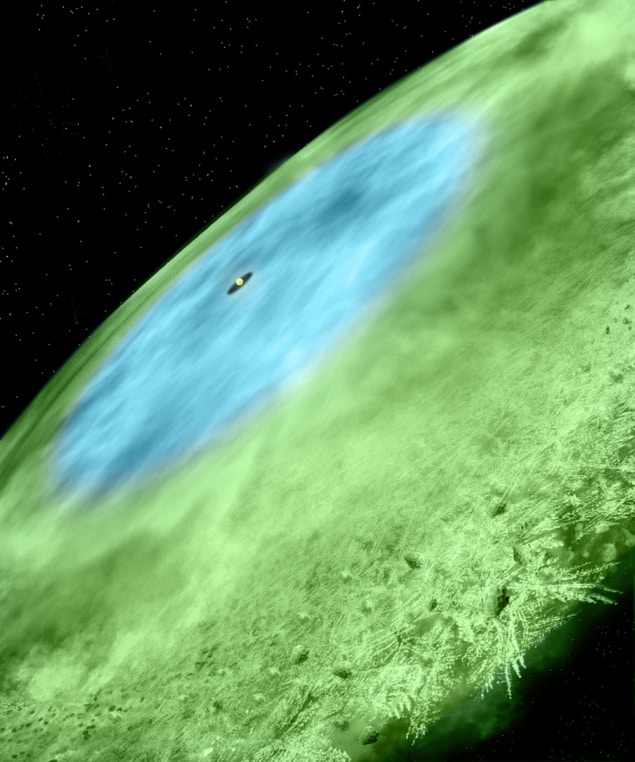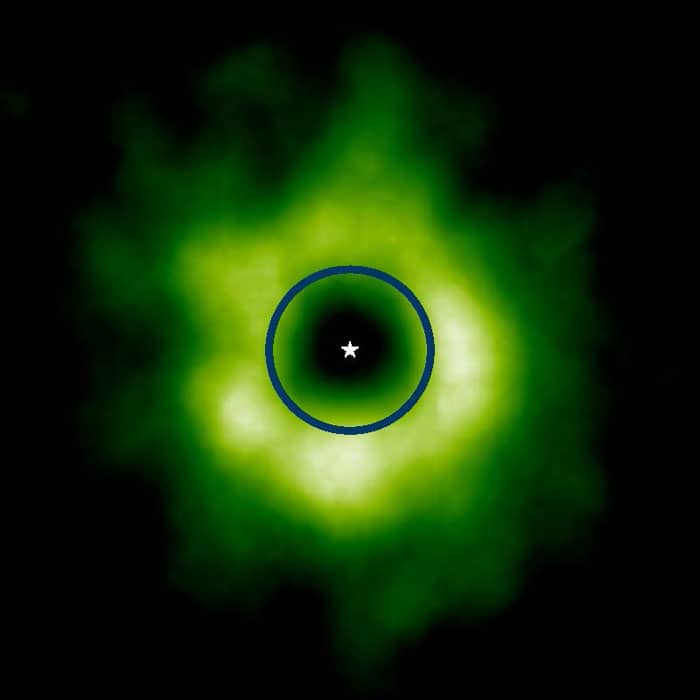
The carbon monoxide (CO) “snow line”, or the distance from a star beyond which CO can freeze, has been directly imaged for the first time by an international team of researchers. The snow line was observed in a protoplanetary disc around the star TW Hydrae and was imaged using the Atacama Large Millimeter/submillimeter Array (ALMA) in Chile. Knowing the locations of such snow lines could help astronomers better understand how planetary systems form and what the planets are composed of, according to the team.
Just as snow lines on Earth are typically seen at high elevations where falling temperatures turn atmospheric moisture to snow, stellar CO snow lines are thought to form in the far, cold reaches of protoplanetary discs that orbit young stars. Depending on the distance from the star, however, other more exotic molecules can freeze and turn to snow.
Freezing point
In addition to CO, other hydrogen compounds such as water, ammonia and methane also condense into solid ice grains at the snow line at a temperature of about 150 K. Water ice freezes first, followed by the other abundant gases that form a sort of frost on the dust grains that will ultimately be the building blocks of planets and comets in that system. The frost line for our solar system is at around 5 AU.
In the new study, Chunhua Qi, of the Harvard-Smithsonian Center for Astrophysics in Cambridge, Massachuttes, along with Karin Oberg, of Harvard University in the US, and colleagues used data from ALMA to study the protoplanetary disc that surrounds TW Hydrae, a young star 175 light-years from Earth. TW Hydrae was choosen because the researchers believe that its disc is comparable to the nebula from which our solar system arose.
“ALMA has given us the first real picture of a snow line around a young star, which is extremely exciting because of what it tells us about the very early period in the history of our solar system,” says Qi. He goes on to say that it is now possible to “see previously hidden details about the frozen outer reaches of another solar system, one that has much in common with our own when it was less than 10 million years old”.

Lifting the veil
But directly imaging a snow line is no easy task – to date, they have only been detected via their spectral signatures and so their precise location and extent could not be nailed down. The difficulty arises because the snow lines form almost exclusively within the narrow central plane of a protoplanetary disc. Above and below the plane, stellar radiation warms the gases and so they cannot freeze. However, the insulating effect of the concentrated dust and gas in the central plane of the disc allows temperatures to drop sufficiently for CO and other gases to cool and freeze, according to the team. And it is this radiation that veils the snow line, preventing astronomers from peering in.
To get round this problem, the researchers looked for a reactive ion – diazenylium (N2H+) – which only appears when CO freezes. That is because diazenylium is destroyed in the presence of CO gas and so would only appear in detectable amounts where the CO had frozen. Diazenylium shines brightly in the millimetre portion of the electromagnetic spectrum, which can be detected by radio telescope such as ALMA. According to the researchers, ALMA’s sensitivity and resolution allowed them to trace the presence and distribution of diazenylium around TW Hydrae, finding a defined boundary at about 30 AU from the parent star.
Diazenylium marks the spot
“Using this technique, we were able to create, in effect, a photonegative of the CO snow in the disc surrounding TW Hydrae,” says Oberg. “With this, we could see the CO snow line precisely where theory predicts it should be – the inner rim of the diazenylium ring.”
Current theories suggest that snow lines help dust grains overcome their normal tendency to collide and self-destruct by giving the grains a stickier outer coating. They also increase the number of solids available and may dramatically speed up the planet-formation process. There are multiple snow lines – such as a water snow line and the CO snow line – each thought to link to the formation of specific kinds of planets. In our solar system, the snow line is thought to separate the terrestrial planets from the jovian planets.
Oberg also points out that the CO snow line is particularly interesting because CO ice is needed to form methanol, which is considered a basic building block that forms more complex organic molecules that are essential for life. “Imaging of snow-line locations in large samples of discs will directly trace how planet formation varies between different systems. The snow line regulates the bulk compositions of planetesimals and planets formed in such systems,” says Qi. The researchers hope that future observations will reveal other snow lines and provide additional insights into the formation and evolution of planets.
The research is published in Science.



